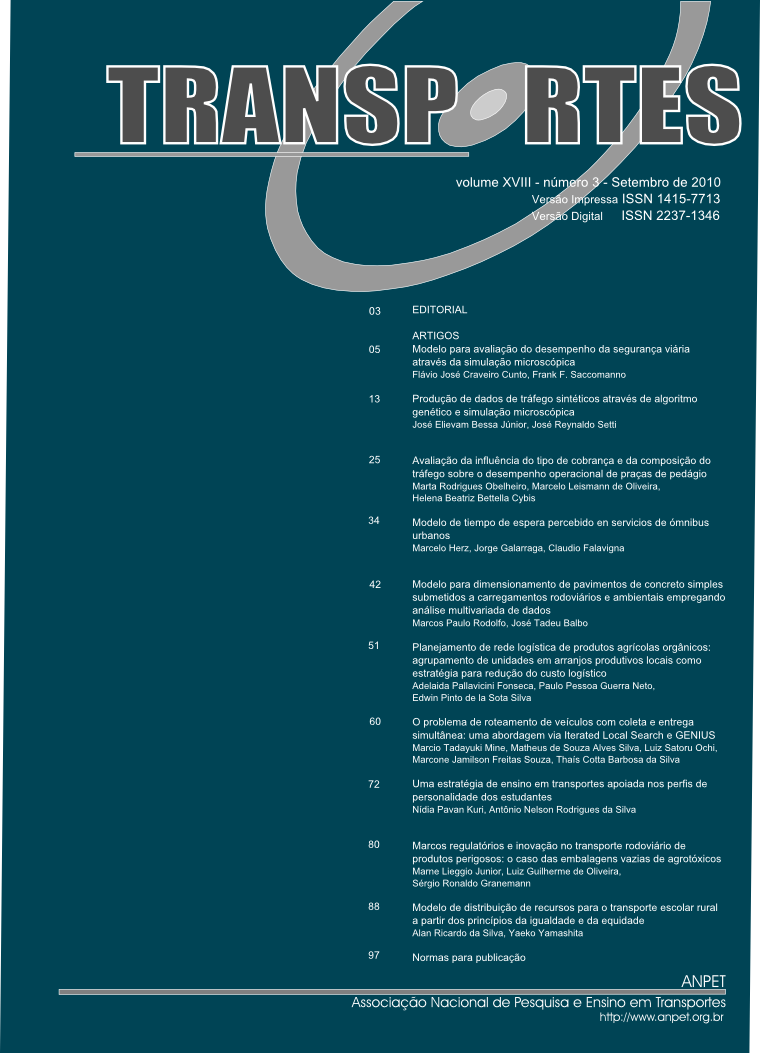Planejamento de rede logística de produtos agrícolas orgânicos: agrupamento de unidades em arranjos produtivos locais como estratégia para redução do custo logístico
DOI:
https://doi.org/10.14295/transportes.v18i3.451Abstract
Resumo: O setor agrícola Brasileiro encontra-se em expansão, tornando-se um dos principais contribuintes do aumento do crescimento do PIB nacional e participação ativa na economia mundial. No entanto, a produção agrícola e agropecuária encontra na infraestrutura logística física seu principal desafio, já que tem que procurar soluções para os problemas de escoamento da produção. Este problema soma-se à falta de planejamento estratégico das cadeias de suprimento, de produção e distribuição, e essencialmente ao problema de planejamento de redes logísticas. Para contribuir na solução deste problema, este trabalho desenvolveu um modelo de planejamento do sistema logístico de distribuição para o setor hortigranjeiro de produtos orgânicos. O modelo propõe a criação de um banco de dados para diagnosticar a situação de áreas de estudos e simular cenários alternativos de redes logísticas, tendo como principais variáveis de decisão: o agrupamento de unidades produtivas, as características de veículos e localizações de pontos de venda alternativos.
Abstract: The Brazilian agricultural sector is under enlargement, becoming one of the main contributors to the growth of national GDP as well active involvement in the worldwide economy. However, the logistic physical infrastructure is the main endeavor for the agricultural and farming production since it’s necessary to find solutions for the problems related to production delivery. This problem must be considered in addition to the lack of strategic planning of supply chains, of production and distribution, and mainly to the problem of logistics networks planning. In order to assist the solution of this problem, this study developed a model for the planning of logistic distribution system to the produce sector for organic products. This model suggests the creation of a database to diagnose the condition of study areas and simulate alternative logistic network scenarios, having as the main variables decision: the grouping of productive units, vehicle characteristics and the location of alternative selling spots.Downloads
Downloads
Published
How to Cite
Issue
Section
License
Authors who submit papers for publication by TRANSPORTES agree to the following terms:
- The authors retain the copyright and grant Transportes the right of first publication of the manuscript, without any financial charge, and waive any other remuneration for its publication by ANPET.
- Upon publication by Transportes, the manuscript is automatically licensed under the Creative Commons License CC BY 4.0 license. This license permits the work to be shared with proper attribution to the authors and its original publication in this journal, and to be adapted for non-commercial purposes, provided appropriate credit is given and any derivative works are distributed under the same terms.
- Authors are authorized to enter into additional separate contracts for the non-exclusive distribution of the version of the manuscript published in this journal (e.g., publishing in an institutional repository or as a book chapter), with recognition of the initial publication in this journal, provided that such a contract does not imply an endorsement of the content of the manuscript or the new medium by ANPET.
- Authors are permitted and encouraged to publish and distribute their work online (e.g., in institutional repositories or on their personal websites) after the editorial process is complete. As Transportes provides open access to all published issues, authors are encouraged to use links to the DOI of their article in these cases.
- Authors guarantee that they have obtained the necessary authorization from their employers for the transfer of rights under this agreement, if these employers hold any copyright over the manuscript. Additionally, authors assume all responsibility for any copyright infringements by these employers, releasing ANPET and Transportes from any responsibility in this regard.
- Authors assume full responsibility for the content of the manuscript, including the necessary and appropriate authorizations for the disclosure of collected data and obtained results, releasing ANPET and Transportes from any responsibility in this regard.









